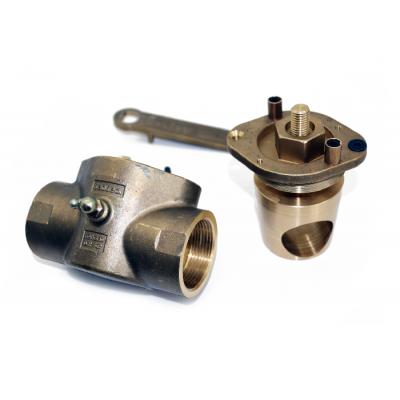A forging is far stronger than a casting and less prone to invisible internal faults
SeaSeal seacocks are forged (or hot stamped) and this is a process where the metal is heated as a billet but not melted. It is stamped with up to 1,000 tons, causing it to ‘flow’ to the desired shape. This process strengthens the metal at the molecular level and produces a consistent, strong component. Forging is used where strength is vital; for example, the undercarriages of aircraft are forged and at a more basic level, blacksmiths forge shoes for horses. However, most seacocks on the market are cast and this is a process where metal is melted and then poured into a mould. It is suitable for many applications and is much cheaper. The result looks much the same but a casting is a weaker product, which can be more porous, brittle and may contain unseen voids, which weaken it further.
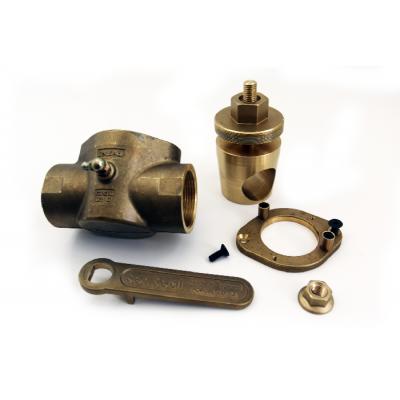
A SeaSeal seacocks is made from traceable, high grade DZR brass alloy (or dezincification resistant) this reduces the risk of corrosion significantly
Metal fittings coming into contact with seawater are highly susceptible to corrosion and although brass does not rust in the same way as steel, it can lose its zinc content and so degrade and become brittle. Leakage of electric current from the boat, or even its neighbours, earths through the water and dissolves the metal parts in a process known as electrolytic corrosion. SeaSeal seacocks use traceable, high grade DZR brass alloy (or dezincification resistant brass) and this reduces the risk of corrosion significantly, especially when it has been forged.
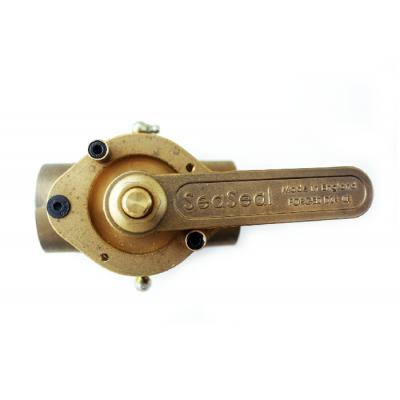
A SeaSeal Seacock potentially removes the need for expensive boat lifting. If for any reason the seacock becomes stuck in the open or closed position it can be freed at sea
Seacocks mostly seize from lack of use. Sea crustaceans will further foul and seize any seacock over time. The SeaSeal seacock can be unseized, not just ashore but also at sea. This is achieved by removing one of the handle stops, slightly releasing the yolk and then winding the cap nut anticlockwise. This draws the cone out of the body slightly, allowing the handle to be worked to clear the blockage. The internal seal on the cone ensures that during this procedure no leakage can take place from the face of the valve into the bilge. Once clear the mechanism is retightened to restore the desired action.
It is a major disadvantage of the ball valve type assembly, when used in seacock applications, that there is no way to unblock it at sea and because it cannot be disassembled it is usually not possible to unblock it ashore either.
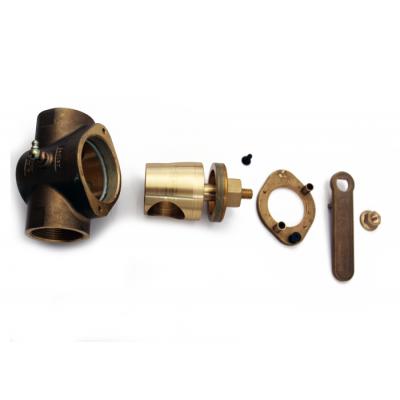
A SeaSeal seacock’s critical components are made from the same material. No more bi-metallic corrosion; the process in which many seacocks become unsafe
A further dezincification acceleration risk occurs where a number of different metals are used in a fitting; for example, if a steel ball is used in a ball valve type brass seacock. Where metals are mixed and in contact with seawater the electrolytic corrosion risk is greatly increased and not necessarily easy to see in the dark recesses of the bilge or inside an apparently sound seacock. Our product is made from DZR throughout and the central cone is also DZR brass. This reduces the risk of corrosion, whilst adding strength and quality.
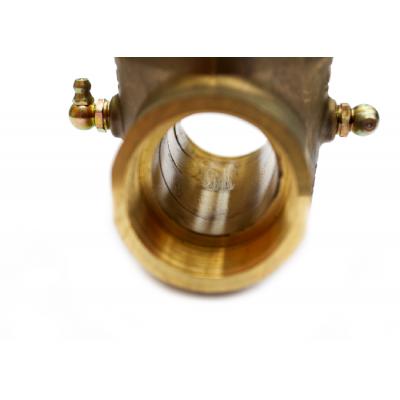
A SeaSeal seacock can be lubricated and is made from self-lubricating Materials
DZR brass is self lubricating and so when two DZR surfaces move together they do not bind in the way that other metals do. In addition each SeaSeal seacocks has two removeable greasing points for added lubrication afloat or ashore. When not in use, the greasing points can also be replaced by DZR brass end caps.
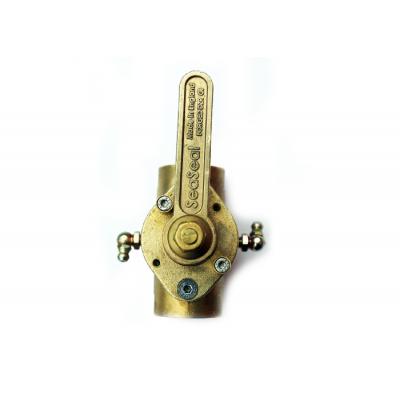
A SeaSeal seacock can be completely and easily disassembled for full inspection so no worrying about the state of the internals
The mechanism of the SeaSeal seacock consists of a bevelled cone, held in place by a screw down cap with an integral nut at the top. The cap is in turn retained by a yolk, which also houses the handle stops. These can be reversed so that the handle can be operated in either direction. This entire internal mechanism can be removed when the boat is ashore. Once disassembled the sealing faces of the body and the cone can be re-polished in the event of damage from foreign bodies. A ball valve, once made, cannot be opened without destroying it. To make matters worse with ball valves, it is very hard to judge when they will fail because the critical parts cannot be inspected, even when the boat is ashore.
When a ball valve is operated, anything in the pipe at the time is free to flow around behind the ball, which sits in a void inside a pipe between two seals. The handle mechanism is also within this void, such that the mechanism is then permanently immersed in a mixture of seawater and corrosive waste (subject to the seacock’s application). When corrosion sets in it is the handle mechanism which is most susceptible and that then fails. When the valve sticks, the only option for freeing it is by extra pressure on the handle, which in turn works the internal mechanism that has been invisibly deteriorating in the dark mix of sea water and waste. The extra pressure to release the valve inevitably leads to the mechanism failing inside the valve, leaving an inaccessible mechanism locked in position. If it is in the open position then the system is open to the sea, so negating the very purpose of a seacock. If it fails in closed position then there is no water supply, which in the case of an engine inlet makes the engine unusable or risks damage. Worse still, you have no idea which scenario you are faced with.
A further feature of ball valves is that the operating handle is usually made of mild steel and this will rust in the salty air of even a fairly dry bilge. The handle then tends to fail at the most inconvenient time even if the mechanism within is still working. The SeaSeal seacock has a forged DZR Brass handle of the same material as the rest of the body to avoid such failures.
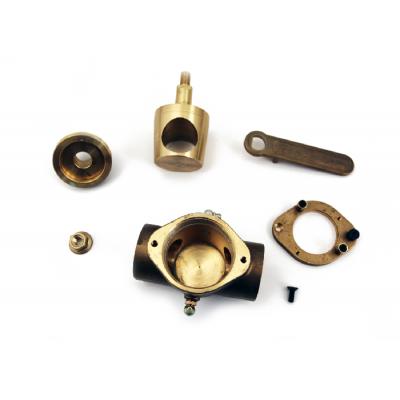
The operation of a SeaSeal seacock is fully adjustable on installation and in use afloat
The action of the SeaSeal seacock is fully adjustable on installation or in use. The brass cone in the centre is held in place by a screw in cap with a spanner adjustment that screws into the seacock. Because the cone has angled sides the action tightens as the cap is screwed down, or releases as the cap is unscrewed. In order to remove any risk that the cap is loosened too much and comes out of the seacock, the mechanism is held in place with a yolk that is screwed into the seacock body. The entire assembly can be disassembled and removed for servicing whilst the boat is ashore. Again, a ball valve cannot be adjusted and the tightness of the action depends on how much torque was applied when its two halves were screwed together at manufacture and cannot be changed.
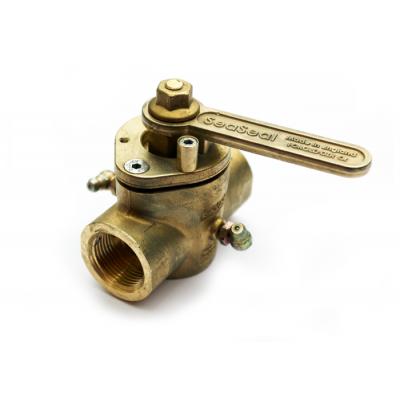
A SeaSeal seacock can be winterised, no more cracked seacocks when the temperature drops below freezing
Water freezing inside any sealed chamber will crack metal and so the ability to winterise a seacock is essential. The SeaSeal seacock can easily be winterised by removing the greasing points on either side of the body. This allows any trapped water to escape from the centre of the cone. This simple procedure can be carried out afloat or ashore. There is no such facility in most ball valves.
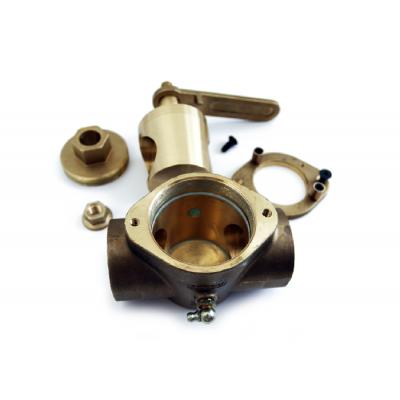
A SeaSeal seacock is highly engineered; manufactured and hand assembled by skilled people in England
We set out to make the best seacock. It is highly engineered and hand assembled. The seacock is made by us in Birmingham, England from traceable, guaranteed material in our ISO accredited factory. See www.tgstamping.co.uk for details of our manufacturing operations.
Some of the other quality touches that you will find, that did not make the key features list:
• The bore of the SeaSeal seacock and associated skin fittings and tails are machined and therefore smooth. This eases flow and so reduces the chance of blocking.
• Where there are screws, to fix the handle stops and retain the yolk, the strength and hardness of steel is needed and so it is top quality, stainless steel. How many times do you find cheap mild steel screw on pieces of marine kit, where they rust, look unsightly and then cannot be operated or removed because the heads have rusted away?
• We couldn’t find a nice flanged brass nut to go on the top of our seacock, so we manufactured our own.
• SeaSeal seacocks have thick walls. You can take one to bits to prove it or see a cut-away version at our retail partner. During our development we cut a number of ball valves in half because that is the only way to see the mechanism. You may be shocked at how little metal stands between you and the bottom of the sea. See the pictures on www.seacocks.co.uk.
